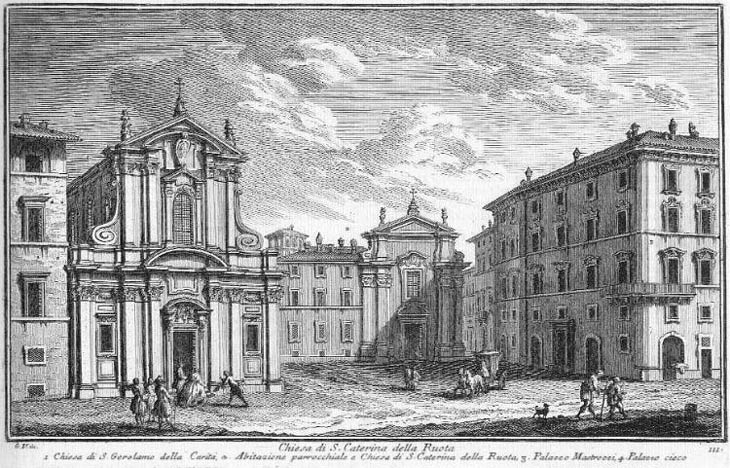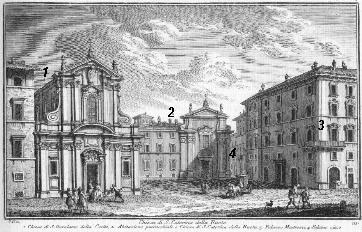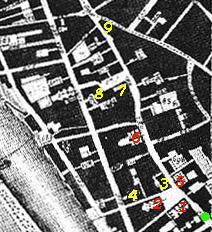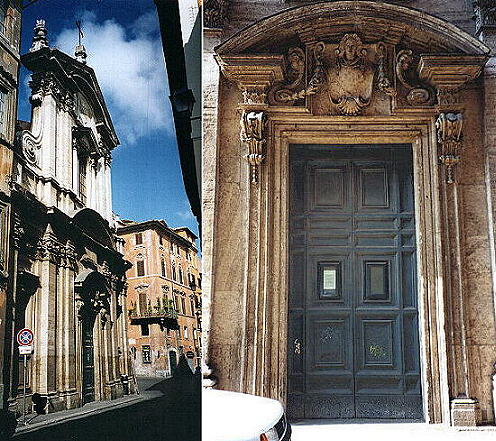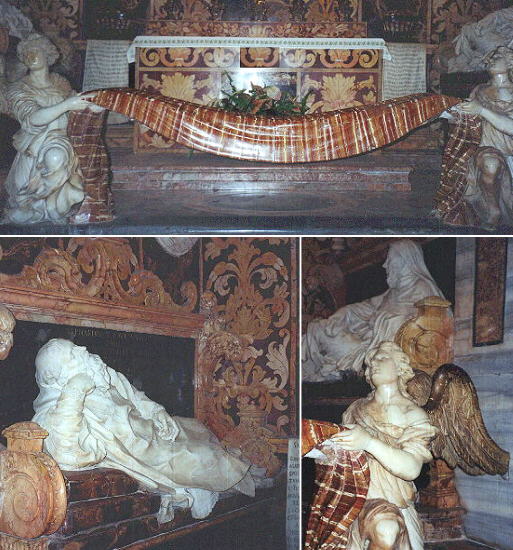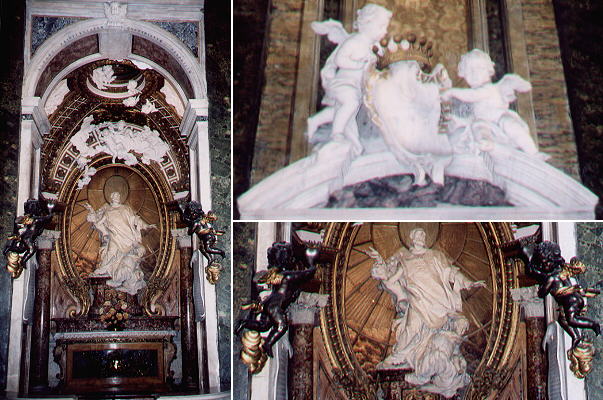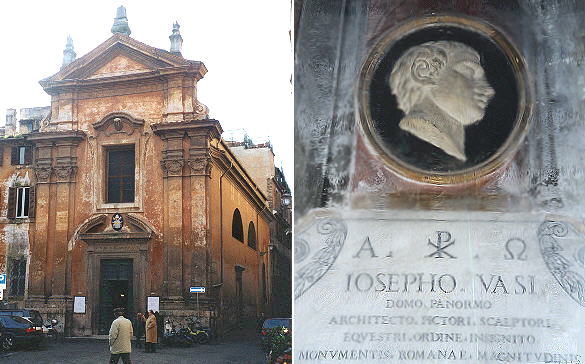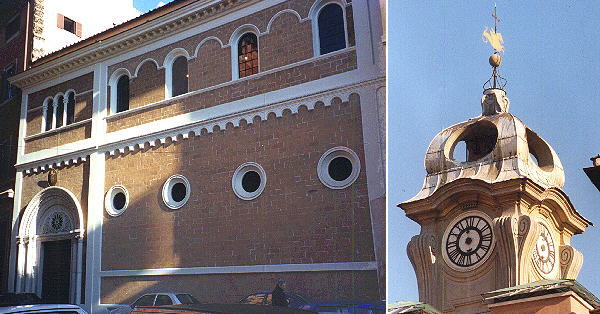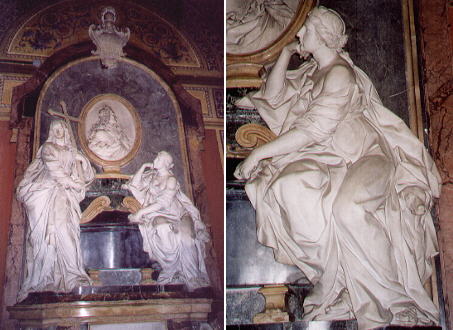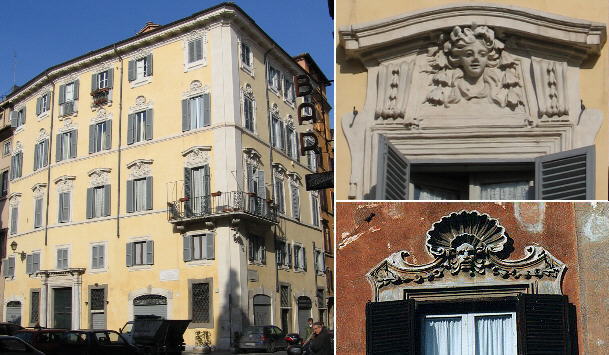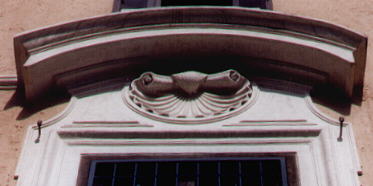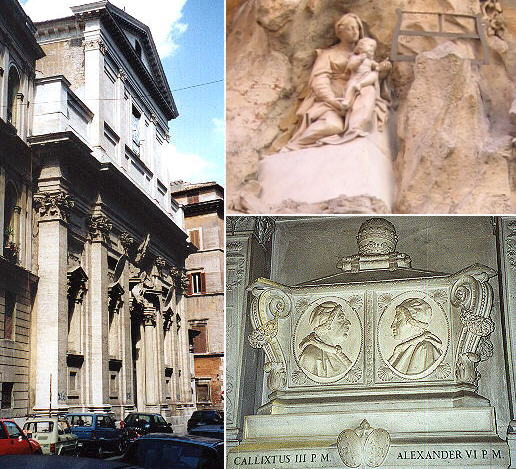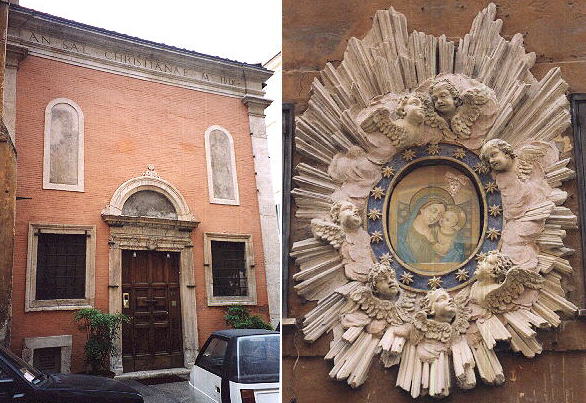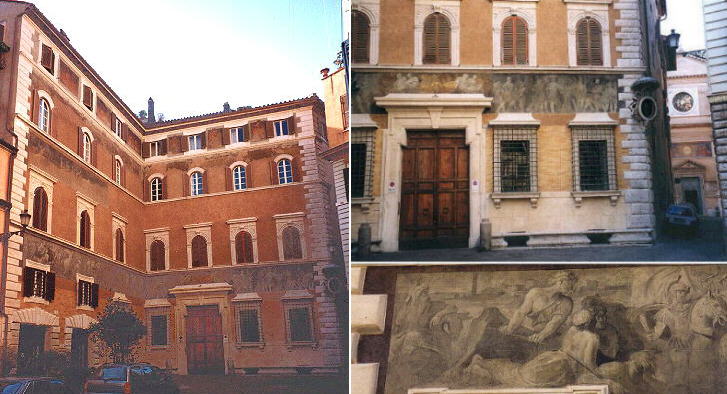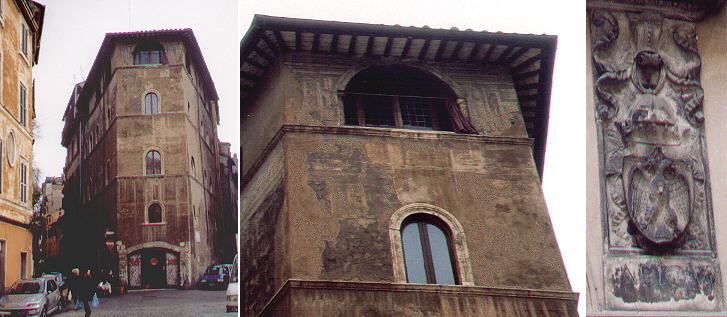  S. Caterina alla Ruota (Book 6) (Map C2) (Day7) (View D6) (Rione Regola) In this page:
In his detailed account of the parish churches Vasi groups in one
plate two minor churches near Palazzo Farnese. The view is taken from the green dot in the small 1748 map here below.
In the description below the plate Vasi made reference to: 1) S. Girolamo della Carità;
2) S. Caterina della Ruota; 3) Palazzo Mastrozzi; 4) Palazzo Cieco (blind).
The small map shows also: 5) S. Tommaso di Canterbury; 6) S. Maria di Monserrato; 7) S. Giovanni in Ayno; 8) Palazzo Ricci; 9) Casa di Pietro Paolo della Zecca.
The view can only cover the church of S. Girolamo della Carità (with the fine façade by Domenico Castelli) and Palazzo Mastrozzi. S. Caterina alla Ruota is in the little square one can guess on the left. Cappella Spada in S. Girolamo della Carità
The chapel of the Spada family was thoroughly redesigned by Virgilio Spada a close friend of Borromini, whose influence on the final design is debated. Before the altar two angels by Antonio Giorgetti (a pupil of Bernini) hold a long marble cloth: one can get access to the chapel by pushing the wooden movable wings of one of the angels (for more baroque angels click here). The somewhat unusual statue of Bernardino Lorenzo Spada portrayed while sleeping is by Ercole Ferrata. Cappella Antamoro in S. Girolamo della Carità
The Sicilian architect Filippo Juvarra came to Rome in 1703 at the age of 25; in the nine years he spent in Rome he had only one opportunity to show his skills. The Antamoro were very wealthy, but definitely not a major Roman family. Their chapel was very small, but Juvarra, who had studied the masterpieces of both Borromini and Bernini, designed a unique and intriguing chapel. It is a pity that Juvarra had to leave Rome to express his talent. During his stay in Rome he published a book showing the finest coats of arms of the Popes.
The little church hosts a monument to Giuseppe Vasi built by his son Mariano. There is a reference to Palermo (Panormo) (he was born in Corleone, a town near Palermo) he is described as an architect, sculptor, painter and then his work as etcher is mentioned. Vasi was buried in S. Gregorio ai Quattro Capi. In the background of this page you can see Vasi's coat of arms. The very fine wooden ceiling of the church was moved here from Capella di S. Francesco d'Assisi when the latter was pulled down in 1883.
Opposite S. Caterina della Ruota there is the church of S. Tommaso (Thomas Becket) di Canterbury. A house with a church for the English pilgrims was built here in 1363. The buildings were modified and enlarged several times. The bell tower (which is clearly visible from Piazza Farnese) was built in 1685 and it clearly shows the influence of Borromini. In 1798 the church was occupied by the French troops and turned into a stable and later on it was damaged by a fire. It was almost entirely rebuilt in the XIXth century; the entrance to the church from Piazza S. Caterina della Ruota is a neo Romanic work of Pietro Camporese and it was completed in 1888 (click here for a list of national churches in Rome). The interior retains an XVIIIth century monument to Sir Thomas Dereham, a close friend of James III Stuart. The monument was designed in 1739 by Ferdinando Fuga. The two statues representing Religion and Faithfulness are a fine work by Filippo della Valle.
The windows of Palazzo Mastrozzi (a XVIIth century building) are decorated in an interesting way. One row has a nice smiling young woman, the other row has Death. As many other more or less famous buildings in Rome Palazzo Mastrozzi was recently repainted using the lighter tints which were in fashion in the XVIIIth century. Vasi mentions in the plate also a XVIIth century little building (Palazzo Cieco) with a fine portal.
S. Maria in Monserrato is another of the "national" churches of Rome and more exactly the church of the Catalans and the Aragoneses. It is dedicated to Monserrat, the sanctuary near Barcelona which means sawed mountain, thus Giovanni Battista Contini (a scholar of Bernini) showed the Infant Jesus holding a saw. The façade was initiated by Francesco da Volterra in 1593, Giovanni Battista Contini completed the lower part in 1675, whilst the upper part was completed in the XIXth century. A little monument contains the mixed ashes of the two Borgia popes (click here for a list of national churches in Rome).
The little church was deconsacrated in the XIXth century and all the internal decoration is lost. A sacred image in the building near the church is the only left reference to S. Giovanni in Ayno.
Palazzo Ricci is a Renaissance palace built by the Florentine Nanni di Baccio Bigio, which retains a painted decoration which was very common in the XVIth century. The paintings were recently restored and show various episodes of the history of Rome. Palazzo Ricci is in a little square near S. Spirito dei Napolitani in Via Giulia. Casa di Pietro Paolo della Zecca
Another Renaissance painted building is the house of Pietro Paolo Francisci, called della Zecca (Mint) as
he was in charge of the mint under Paulus II (1464-71). It was painted with scenes related to Clelia, the
legendary Roman girl who escaped from the enemy camp and
returned to Rome crossing the Tiber near the point where the house was built. While the paintings are gone the
building is still interesting for its design at the junction of Via del Pellegrino and Via di Monserrato. Pietro Paolo della
Zecca hosted in this house Eleanor of Portugal who married in 1462 in Rome the Austrian Emperor Frederic III: in memory of the
event a relief with the Habsburg's double-headed eagle was walled on the right side of the building. In the XIXth century
however the double-headed eagle became a symbol of the Austrian domination in Italy and soon after 1870, when Rome
became the capital of Italy, the relief was moved to the courtyard of S. Maria dell'Anima.
The letters AEIOU below the eagle stand for Austriae Est Imperare Orbi Universo (it is the role of Austria to rule over the whole world).
Next plate in Book 6: S. Maria in Monticelli Next step in Day 7 itinerary: Palazzo Sacchetti Next step in your tour of Rione Regola: Palazzo Montoro
Go
to |
All images © 1999 - 2005 by Roberto Piperno. Write to romapip@quipo.it
